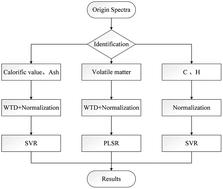当前位置:
X-MOL 学术
›
J. Anal. At. Spectrom.
›
论文详情
Our official English website, www.x-mol.net, welcomes your feedback! (Note: you will need to create a separate account there.)
Improved measurement in quantitative analysis of coal properties using laser induced breakdown spectroscopy
Journal of Analytical Atomic Spectrometry ( IF 3.4 ) Pub Date : 2020-03-07 , DOI: 10.1039/c9ja00429g Yongsheng Zhang 1, 2, 3, 4, 5 , Meirong Dong 1, 2, 3, 4, 5 , Lihua Cheng 4, 6, 7 , Liping Wei 1, 2, 3, 4, 5 , Junbin Cai 1, 2, 3, 4, 5 , Jidong Lu 1, 2, 3, 4, 6
Journal of Analytical Atomic Spectrometry ( IF 3.4 ) Pub Date : 2020-03-07 , DOI: 10.1039/c9ja00429g Yongsheng Zhang 1, 2, 3, 4, 5 , Meirong Dong 1, 2, 3, 4, 5 , Lihua Cheng 4, 6, 7 , Liping Wei 1, 2, 3, 4, 5 , Junbin Cai 1, 2, 3, 4, 5 , Jidong Lu 1, 2, 3, 4, 6
Affiliation

|
It is of great significance to realize the rapid or online analysis of coal properties for optimization of combustion in thermal power plants. In this work, a set of calibration schemes based on laser induced breakdown spectroscopy (LIBS) was determined to improve the measurements in quantitative analysis of coal properties, including proximate analysis (calorific value, ash, volatile content) and ultimate analysis (carbon and hydrogen). Firstly, different normalization methods (channel normalization and normalization over the whole spectral area) combined with two regression algorithms (partial least squares regression [PLSR] and support vector regression [SVR]) were compared to make an initial selection of the appropriate calibration method for each indicator. Then, the influence of de-noising by wavelet threshold de-noising (WTD) on quantitative analysis was further studied, whereby the final analysis schemes for each indicator were determined. The results showed that WTD coupled SVR can make a good estimate of calorific value and ash: the root mean square errors of prediction (RMSEP) were 0.80 MJ kg−1 and 0.60%. Coupling of WTD and PLSR performed best for the measurement of volatile content, and the RMSEP was 0.76%. For the quantitative analysis of carbon and hydrogen, normalization over the whole spectral area combined with SVR can get better measurement results, and the RMSEP of the measurements were 1.08% and 0.21%, respectively. The corresponding average standard deviations (RSD) for calorific value, ash, volatile content, carbon and hydrogen of the validation sets were 0.26 MJ kg−1, 0.57%, 0.79%, 0.47% and 0.08%, respectively. The results demonstrated that the selection of appropriate spectral pre-processing coupled with calibration strategies for each indicator can effectively improve the accuracy and precision of measurements of coal properties.
中文翻译:

使用激光诱导击穿光谱法对煤炭特性进行定量分析的改进测量
实现煤炭特性的快速或在线分析对优化火电厂燃烧具有重要意义。在这项工作中,确定了一套基于激光诱导击穿光谱法(LIBS)的校准方案,以改进煤炭性质定量分析中的测量,包括近似分析(热值,灰分,挥发物含量)和最终分析(碳和氢) )。首先,比较了不同的归一化方法(通道归一化和整个光谱区域的归一化)与两种回归算法(偏最小二乘回归[PLSR]和支持向量回归[SVR])的比较,以初步选择合适的校正方法用于每个指标。然后,进一步研究了小波阈值降噪(WTD)降噪对定量分析的影响,从而确定了各指标的最终分析方案。结果表明,WTD耦合SVR可以很好地估算发热量和灰分:预测的均方根误差(RMSEP)为0.80 MJ kg-1和0.60%。WTD和PLSR的耦合最适合测量挥发物含量,RMSEP为0.76%。对于碳和氢的定量分析,在整个光谱区域与SVR结合进行归一化可以获得更好的测量结果,测量的RMSEP分别为1.08%和0.21%。对于热值,灰分,挥发物含量,碳和氢的验证集的相应的平均标准偏差(RSD)为0.26千克MJ -1,0.57%,0.79%,分别为0.47%和0.08%。结果表明,为每个指标选择合适的光谱预处理方法和校准策略可以有效地提高煤质测量的准确性和精度。
更新日期:2020-04-24
中文翻译:

使用激光诱导击穿光谱法对煤炭特性进行定量分析的改进测量
实现煤炭特性的快速或在线分析对优化火电厂燃烧具有重要意义。在这项工作中,确定了一套基于激光诱导击穿光谱法(LIBS)的校准方案,以改进煤炭性质定量分析中的测量,包括近似分析(热值,灰分,挥发物含量)和最终分析(碳和氢) )。首先,比较了不同的归一化方法(通道归一化和整个光谱区域的归一化)与两种回归算法(偏最小二乘回归[PLSR]和支持向量回归[SVR])的比较,以初步选择合适的校正方法用于每个指标。然后,进一步研究了小波阈值降噪(WTD)降噪对定量分析的影响,从而确定了各指标的最终分析方案。结果表明,WTD耦合SVR可以很好地估算发热量和灰分:预测的均方根误差(RMSEP)为0.80 MJ kg-1和0.60%。WTD和PLSR的耦合最适合测量挥发物含量,RMSEP为0.76%。对于碳和氢的定量分析,在整个光谱区域与SVR结合进行归一化可以获得更好的测量结果,测量的RMSEP分别为1.08%和0.21%。对于热值,灰分,挥发物含量,碳和氢的验证集的相应的平均标准偏差(RSD)为0.26千克MJ -1,0.57%,0.79%,分别为0.47%和0.08%。结果表明,为每个指标选择合适的光谱预处理方法和校准策略可以有效地提高煤质测量的准确性和精度。



























 京公网安备 11010802027423号
京公网安备 11010802027423号